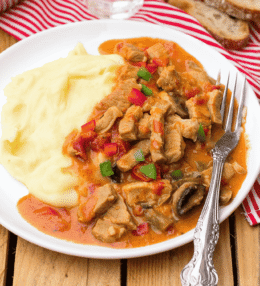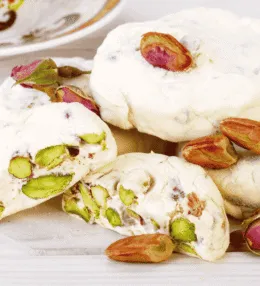
- View
Table of Contents
ToggleRoti Canai is one of Malaysia’s most iconic street foods, known for its flaky layers, golden crust, and the rich curries it’s often served with. Whether eaten for breakfast, lunch or a late night snack, it delivers a comforting experience that’s woven into daily life across the country.
This flatbread is not just about the bite. It is about the sound of it being flipped on a hot griddle, the sight of it being spun in the air, and the scent of ghee mingling with spiced dhal or chicken curry. Roti Canai captures Malaysia’s diversity in one delicious parcel.
Want to dive deeper into Malaysian Cuisine? Don’t miss our post on 27 Traditional Malaysian Foods to Try
What Is Roti Canai?
At a glance, Roti Canai might seem like a simple flatbread, but its preparation and presentation reflect a deeper culinary craft. The dough is stretched by hand until paper thin, then folded, coiled, and griddled until crisp outside and tender inside.
Typically served with a small bowl of dhal, or sometimes with meat or fish curry, it’s meant to be torn and dipped. In many places, you’ll also find it paired with sugar or condensed milk, transforming it from savoury to sweet with ease.
Ingredients and Taste
The dough begins with just a few basics: flour, water, salt and ghee. Some versions include condensed milk or egg for added richness. It’s kneaded until smooth, then left to rest, allowing the gluten to relax and the dough to become elastic enough for stretching.
Once rested, each portion is stretched thin, then folded repeatedly to create layers. As it cooks on a flat griddle, ghee is added to crisp the edges and bring out a rich, slightly nutty aroma. The final result is soft on the inside with golden, flaky edges.
Taste wise, Roti Canai walks the line between buttery and neutral, acting as the perfect partner to bold, spiced gravies. The dhal is typically mild and earthy, while chicken or fish curry brings heat and depth, making every bite dynamic and layered.
There’s something deeply satisfying about tearing into a fresh Roti Canai. Its texture alone makes it special, but the way it soaks up curry, balancing heat with richness, is where its true magic lies. It’s the kind of dish you remember not just for its flavour, but for how it made you feel.
A Taste of History
Roti Canai’s origins are widely linked to Indian Muslim immigrants, particularly those from southern India who brought with them the techniques of roti making and spice blending. The word “Canai” is believed to refer to Chennai, a nod to its Tamil roots.
Over time, it evolved into something uniquely Malaysian. Local influences shaped the way it’s prepared and served, and today, you’ll find countless variations across the country. From savoury fillings like egg or sardine to sweet versions with banana or kaya, it’s incredibly adaptable.
Beyond its Indian heritage, Roti Canai reflects Malaysia’s broader cultural mosaic. It’s found in roadside stalls, night markets, and cafes, prepared by people from different backgrounds, each adding a subtle twist to the familiar dough and curry.
More than just a meal, Roti Canai tells a story of migration, adaptation and community. It’s a dish that has travelled across oceans and generations, but still tastes like home to millions. Whether eaten with hands or fork and spoon, it connects people through shared flavour and ritual.

Malaysian Roti Canai (Flatbread with Curry)
Ingredients
For the Roti Dough:
- 300 g plain flour
- 1 tsp salt
- 1 tbsp condensed milk
- 2 tbsp vegetable oil plus extra for greasing
- 180 ml warm water adjust as needed
- 30 g unsalted butter or ghee melted (for stretching and cooking)
For the Curry Sauce (Simple Dhal or Chicken Curry Option):
- 2 tbsp vegetable oil
- 1 medium onion finely chopped
- 2 cloves garlic minced
- 1 tsp grated ginger
- 1 tbsp curry powder Malaysian style if available
- 200 ml coconut milk
- 250 ml water
- Salt to taste
- Optional 100g red lentils or 200g chicken thigh pieces
Instructions
- To begin, sift the flour into a large bowl and stir in the salt. Add the condensed milk, oil, and half the warm water. Mix with your fingers or a wooden spoon until a shaggy dough forms. Gradually add more water as needed to bring the dough together without it becoming sticky.
- Knead the dough on a lightly oiled surface for 10 minutes until it becomes smooth, elastic, and slightly glossy. Divide into 4 equal balls. Coat each with oil and place them in a greased container. Cover with cling film and rest at room temperature for at least 1 hour (or overnight in the fridge for better flavour and stretch).
- While the dough rests, prepare the curry. Heat oil in a saucepan over medium heat. Add onions and sauté until golden. Stir in garlic, ginger, and curry powder. Cook for 1 minute to release the aroma.
- Pour in the coconut milk and water. Add lentils or chicken if using. Simmer on low heat, stirring occasionally, until the lentils are tender or the chicken is fully cooked, roughly 20 minutes. Season with salt to taste. Set aside and keep warm.
- Once the dough has rested, generously oil your work surface and hands. Take one dough ball, flatten it slightly, and gently stretch it outwards with your fingertips, rotating as you go. The goal is to create a large, thin sheet, almost transparent.
- Drizzle the stretched dough with melted butter or ghee. Fold the edges inward like an envelope, forming a square or coil, depending on preference. Repeat with the remaining dough balls.
- Heat a heavy based frying pan or griddle over medium to high heat. Lightly grease with oil or ghee. Place one roti on the pan, seam side down. Cook for 2–3 minutes per side until puffed, golden, and crispy in spots.
- Use two spatulas or the edge of your hands to lightly “fluff” the roti once cooked, clapping the sides helps create layers and flakiness. Transfer to a plate and cover loosely with a tea towel to keep warm.
- Repeat the cooking process for all the rotis. Adjust the heat as needed to prevent burning, and re-grease the pan lightly between batches.
- Serve the roti warm with the curry on the side or poured over. Garnish with fresh coriander if desired. For extra depth, offer sambal, pickled onions, or a soft boiled egg. Best enjoyed fresh and hot.
Nutrition
You May Also Like







Leave a Review